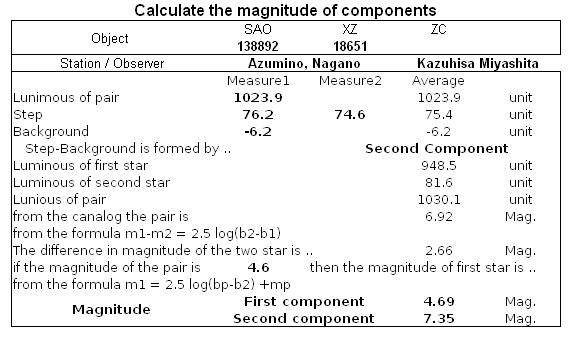Analysis of multiple star XZ18651(SAO138892,chi Virginis) occultation
June 30, 2007
Kazuhisa Miyashita
1. Previous observation and prediction of this event
Chi Virginis is multiple star contain the component 4.8 mag.(A), 8.8 mag.(B), 9.1 mag.(C) and 10.4 mag(D). The component B was found from grazing occultation by Richard Wilds and Robert L. Sandy at Dec.31 1988. In the Occultation Newsletter 5.2 p55-p56, Tony Murray described that the separation is 0.1 arcsec and position angle is 214 degree, and ithe data was obtained from the visual observation of graze event. The prediction derived from OCCULT 3.6 is below.
Table 1. Prediction obtained from OCCULT 3.6
2. Analysis using Limovie
Figure 1. Light curve of XZ18651 event
Table 2. Calculateion of Lunar Velocity

Figure 2. Light curve and diffraction fitting
The weather condition of this event was severe for observation. Thin clouds were spreading over the sky and the star was blurred. The fitting could not use the GRAZING mode because the noise obstruct the fitting at the part of high brightness. Then, the fitting was performed using OCCULTATION mode with contact angle set to 17 degree obtained from OCCULT 3.6.
3. Analyzing event time
No.298.5 frame is .. exposure beginning at 12:29:42.517, exposure end at 12:29:42.534, then the centre of exposure is 12:29:42.526
Then,
First event : No.298.5 frame – 18 millisecond = 12:29:42.526 – 18 = 12:29:42.508 +/- 0.017sec
Second event : No.298.5 frame + 44 millisecond = 12:29:42.526 + 44 = 12:29:42.570 +/- 0.017sec
4. Magnitude of components
Table 3. Magnitude of components

5. Astrometry
Figure 4. Astrometry of the component A and B
Time difference between the event of primary star and component is 0.062 milliseconds. Then the distance between lunar limb and the line, which passes at the component and is parallel to the lunar limb, is ...
Distance = Radial Velocity * Time difference = 0.355 [milli arc second / secomd] * 0.062 [second] = 0.022 [milli arc second]
6. Discussion
Sandy l(1988) described that the component B was visible several seconds while the primary A was occulted. From this, it is concluded that the component B is at west of primary star, and the position angle was calculated 214 degree. In the event of June 23, 2007 observed Azumino-City in Japan, the position angle is 107 degree. Therefore the 8.8 magnitude component is expected to disappear earlier than primary. However, in the observation at June 23, 2007 event, the faint star which is thought the component B is disappeared later than primary star. Figure 4 shows the astrometry of this event. If the moon limb doesn't have large undulation then the position angle is thought smaller than 197 degree.